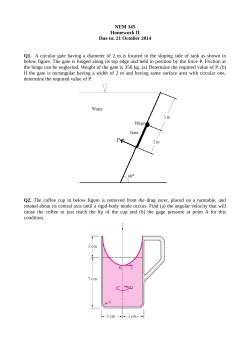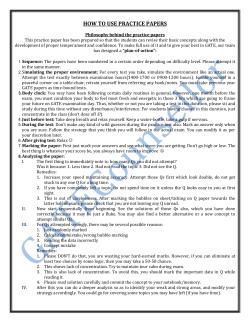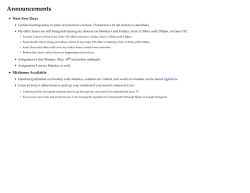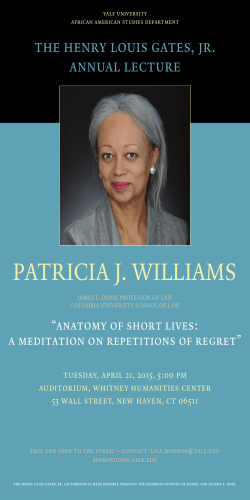
Apr 22 - Illinois Institute of Technology
Illinois Institute of Technology Lecture 20 Logic Gates CS 350: Computer Organization & Assembler Language Programming A. Why? • Logic gates are the lowest level of hardware that deal with logical values. B. Outcomes After this lecture, you should • Know the symbols for the logic gates. • Be able to trace the execution of a simple logic circuit. • Be able to convert between truth tables, logical formulas, and loop-free logic circuits. C. Logic Gates • A logic gate is a device that performs a logical calculation by taking logical inputs and producing logical output(s). • (We’re interested in electronic logic gates.) • Symbols for gates NOT AND OR XOR NAND NOR XNOR • Note little circle indicates negation. • Binary XNOR (“eks-nore”) is logical equivalence (i.e., iff). • Can extend binary gates to n-ary gates (n inputs, 1 output). • E.g., AND(X, Y, Z, U) = ((X AND Y) AND Z) AND U). • OR(X, Y, Z, U) = ((X OR Y) OR Z) OR U). CS 350: Comp Org & Asm Pgm’g –1 – © James Sasaki, 2015 Illinois Institute of Technology Lecture 20 • Since AND and OR are associative, parenthesization isn’t important. • n-way NAND/NOR/XNOR are the NOT of n-way AND/OR/XOR • n-way XOR yields true iff an odd number of inputs are true. • n-way XNOR yields true iff an even number of inputs are true. • Adding a circle to an output or input has the same effect as a NOT gate: AND NOT NOT AND equals NAND equals AND • It's straightforward to combine gates to calculate simple boolean expressions. • Note the time it takes for a circuit to stabilize depends on the length of the longest path through the circuit. (The shorter the longest path, the faster the circuit, in general.) D. Translating From a Simple Logic Circuit To a Propositional Formulas • A simple logic circuit diagram can be translated to an equivalent propositional formula. It must be a combinatorial circuit: It must have no loop. • Start with the gate(s) that connect directly to the circuit’s inputs and label the output of each gate with the proposition for that gate and its inputs. • Continue finding gates that have two labeled inputs and labeling their outputs. Here's an example: X Y AND X AND Y (X AND Y) OR Z OR Z CS 350: Comp Org & Asm Pgm’g –2 – © James Sasaki, 2015 Illinois Institute of Technology Lecture 20 or X AND Y XY XY+Z OR Z E. Translating Between Truth Tables and Propositional Formulas • The trick in converting from a truth table to a corresponding propositional formula is to notice that each row of a truth table corresponds to a unique conjunction of the variables (with each variable possibly negated). • Example: X̅ Y̅ + X Y̅ describes the truth table below X Y Proposition Z 0 0 X̅ ̅ Y̅ ̅ 1 0 1 X̅ ̅ Y 0 1 0 X Y̅ ̅ 1 1 1 X Y 0 • (Note: In the trivial cases, all the outputs are 0 or 1 and we can use 0 or 1 as the expression.) • Disjunctive normal form: The propositional formula that corresponds to a truth table has a specific format: It’s the disjunction (OR) of some terms, where each term is the conjunction (AND) of some possibly-negated variables (a.k.a. “atoms” or “literals”). This format is called disjunctive normal form. (A normal form is just a standard way of writing something.) ̅ + X Z and X Z + Y Z are both in DNF, but (X+Y ) Z is not • Examples: X̅ Y in DNF even though it's equivalent to X Z + Y Z. • A DNF expression is in Full DNF if each term includes all the variables of the expression. • Example: X Y Z + X Y̅ Z + X Y Z + X̅ Y Z is in full DNF. CS 350: Comp Org & Asm Pgm’g –3 – © James Sasaki, 2015 Illinois Institute of Technology Lecture 20 • Example: X Z + Y Z is in DNF but not full DNF (the first term is missing Y or Y̅; the second is missing X or X̅). • You can convert an expression from DNF to full DNF by inserting (V + V̅ )̅ for missing variables V and expanding by distributing AND over OR • Example: X Z + Y Z = X (Y + Y̅ )̅ Z + (X + X̅ )̅ Y Z = X Y Z + X Y̅ ̅ Z + X Y Z + X̅ ̅ Y Z = X Y Z + X Y̅ ̅ Z + X̅ ̅ Y Z • This technique can produce long propositions that have shorter equivalents. Algebraic manipulations can be used to simplify the expression. • One way to convert from a propositional formula to a truth table is to use DNF: Use rules like DeMorgan’s laws and distribution to expand the formula and then use excluded middle, contradiction, maybe double negation elimination (a.k.a. Pierce’s law), and domination (F X = F; T + X = T ) to simplify.zzssdqdcdc F. Translating From a Truth Table to a Simple Logic Circuit • A Programming Logic Array (PLA) is a general structure for implementing a truth table using logic gates. It relies on the disjunctive normal form representation of a truth table as a logical expression. • Each conjunct corresponds to an AND gate with literals as its inputs. The outputs of selected AND gates are all sent to an OR gate, and the output of the OR gate corresponds to the value in the truth table. • A table with n logical inputs has 2n rows (one for each gate). E.g., A table with inputs X and Y has 2² = 4 rows. Note that for each input that is negated, we insert a NOT gate before the input goes to the AND gate. CS 350: Comp Org & Asm Pgm’g –4 – © James Sasaki, 2015 Illinois Institute of Technology X Y 0 0 0 1 1 0 Lecture 20 Proposition Gate _ _ XY X X̅ ̅ Y̅ ̅ Y AND _ XY X X̅ ̅ Y Y AND _ XY X X Y̅ ̅ Y AND X 1 1 X Y Y XY AND We begin with none of the AND gate outputs sent to the OR gate: X Y __ XY AND _ XY AND _ XY Output OR AND XY AND CS 350: Comp Org & Asm Pgm’g –5 – © James Sasaki, 2015 Illinois Institute of Technology Lecture 20 • To program a PLA, we connect the AND gates that correspond to output T to the OR gate; the AND gates that correspond to output F don’t get connected. E.g., for the earlier truth table, we get: X __ XY AND Y _ XY AND _ XY Output OR AND XY AND • If we’re designing a circuit, we can simplify it tossing out the unused AND gates (and OR inputs). E.g., For the earlier truth table, we get X __ XY AND Y _ XY Output OR AND • (For a physical PLA, the unused AND gates and OR inputs don’t get deleted, we just don’t use them.) • An actual PLA can have multiple outputs in addition to multiple inputs. (For an example, see Figure 3.17.) CS 350: Comp Org & Asm Pgm’g –6 – © James Sasaki, 2015 Illinois Institute of Technology Lecture 20 Fig 3.17: 3-bit input, 4-bit output PLA CS 350: Comp Org & Asm Pgm’g –7 – © James Sasaki, 2015 Illinois Institute of Technology Activity 20 Logic Gates CS 350: Computer Organization & Assembler Language Programming A. Why? • Logic gates are the lowest level of hardware that deal with logical values. B. Outcomes After this activity, you should be able to: • Read and write the symbols for the logic gates. • Trace the execution of a simple logic circuit. • Convert between truth tables, logical formulas, and loop-free logic circuits. C. Questions 1. Translate the logic gate circuit below to its equivalent boolean expression. Do a direct translation — don't simplify the expression. P OR Q NOR NAND R Z AND OR 2. Let E be the expression X̅ ̅ Y + ¬(X̅ ̅ + Y̅ )̅ + ¬(X + Y). (a) Write a logic gate implementation for E. Don’t modify or simplify E. (b) Use DeMorgan’s laws (and possibly Pierce’s law for removing double negations) to simplify E to full DNF. Write a logic gate implementation for this full DNF expression. (I.e., the PLA circuit for E.) CS 350: Comp Org & Asm Pgm’g –8 – © James Sasaki, 2015 Illinois Institute of Technology 3. Activity 20 Repeat Problem 2 on the expression Y̅ ̅ (X̅ Y ̅ Z) + (X ⊕ Y) Z + ¬(X → Y̅ )̅ Z. (Read the ⊕ operator as XOR.) [For P → Q, use ¬P+Q.] CS 350: Comp Org & Asm Pgm’g –9 – © James Sasaki, 2015 Illinois Institute of Technology Activity 20 Solution 1. The expression is ¬(¬(P̅ ̅+Q +Q R)(Q R +R)). The expressions for the different parts of the diagram are shown in red below. P P+Q OR ¬(P+Q+Q R) Q NOR NAND R AND QR Z ¬(¬(P+Q+Q R)(Q R+R)) OR Q R+R 2. (The expression E = X̅ ̅ Y + ¬(X̅ ̅ + Y̅ )̅ + ¬(X + Y)) a. A direct translation of E to a logic circuit: X Y AND E NOR OR NOR CS 350: Comp Org & Asm Pgm’g – 10 – © James Sasaki, 2015 Illinois Institute of Technology b. Activity 20 Using DeMorgan's laws X̅ Y + ¬(X̅+ Y̅) + ¬(X + Y) = X̅Y + XY + X̅ Y̅. X Y AND E AND OR AND 3. (The expression Y̅ ̅ (X̅ Y ̅ Z) + (X ⊕Y) Z + ¬(X → Y̅ )̅ Z, where ⊕ is XOR) a. A direct translation to a logic gate circuit: AND X AND XOR Y AND OR NOR AND Z b. For the expansion to full DNF, it might be easiest to do this in parts: • Y̅ ̅ (X̅ ̅Y Z) = 0 (because of Y̅ ̅ and Y) • (X ⊕ Y) Z = (X Y̅ ̅ + X̅ ̅ Y ) Z = X Y̅ ̅ Z + X̅ ̅ Y Z CS 350: Comp Org & Asm Pgm’g – 11 – © James Sasaki, 2015 Illinois Institute of Technology Activity 20 • ¬(X → Y̅ )̅ Z = ¬(X̅ ̅ + Y̅ ̅ ) Z = X Y Z (by DeMorgan’s Law) Combining, Y̅ ̅ (X̅ Y ̅ Z) + (X ⊕ Y) Z + ¬(X → Y̅ )̅ Z = 0 + X Y̅ ̅ Z + X̅ ̅ Y Z + X Y Z = X̅ ̅ Y Z + X Y̅ ̅ Z + X Y Z The PLA circuit is X AND Y Z CS 350: Comp Org & Asm Pgm’g AND OR AND – 12 – © James Sasaki, 2015
© Copyright 2025











